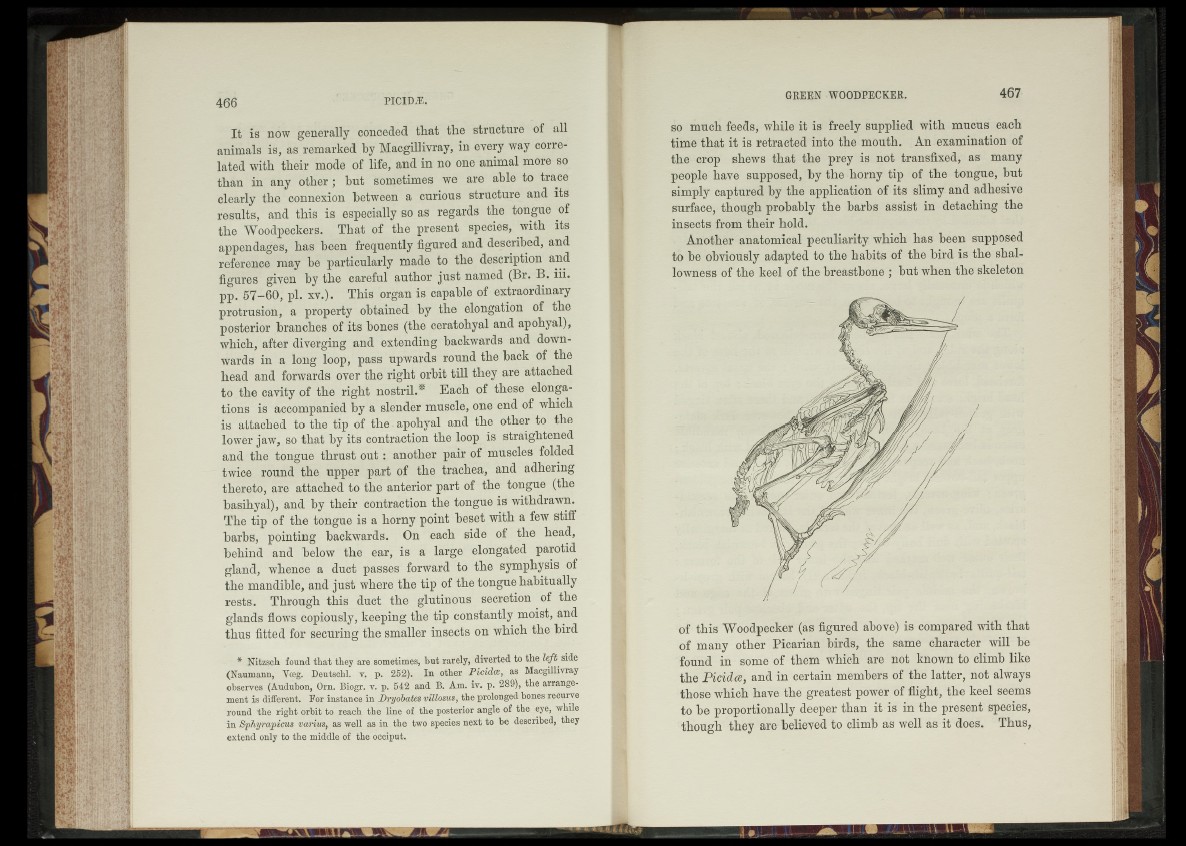
It is now generally conceded that the structure of all
animals is, as remarked by Macgillivray, in every way correlated
with their mode of life, and in no one animal more so
than in any other; but sometimes we are able to trace
clearly the connexion between a curious structure and its
results, and this is especially so as regards the tongue of
the Woodpeckers. That of the present species, with its
appendages, has been frequently figured and described, and
reference may be particularly made to the description and
figures given by the careful author just named (Br. B. iii.
pp. 57-60, pi. xv.). This organ is capable of extraordinary
protrusion, a property obtained by the elongation of the
posterior branches of its bones (the ceratohyal and apohyal),
which, after diverging and extending backwards and downwards
in a long loop, pass upwards round the back of the
head and forwards over the right orbit till they are attached
to the cavity of the right nostril.* Each of these elongations
is accompanied by a slender muscle, one end of which
is attached to the tip of the apohyal and the other to the
lower jaw, so that by its contraction the loop is straightened
and the tongue thrust o u t: another pair of muscles folded
twice round the upper part of the trachea, and adhering
thereto, are attached to the anterior part of the tongue (the
basihyal), and by their contraction the tongue is withdrawn.
The tip of the tongue is a horny point beset with a few stiff
barbs, pointing backwards. On each side of the head,
behind and below the ear, is a large elongated parotid
gland, whence a duct passes forward to the symphysis of
the mandible, and just where the tip of the tongue habitually
rests. Through this duct the glutinous secretion of the
glands flows copiously, keeping the tip constantly moist, and
thus fitted for securing the smaller insects on which the bird
* Nitzsch found that they are sometimes, but rarely, diverted to the left^ side
(Naumann, Voeg. Deutschl. v. p. 252). In other Picidee, as Macgillivray
observes (Audubon, Orn. Biogr. v. p. 542 and B. Am. iv. p. 289), the arrangement
is different. For instance in Dryobates villosus, the prolonged bones recurve
round the right orbit to reach the line of the posterior angle of the eye, while
in Sphyrapicus varius, as well as in the two species next to be described, they
extend only to the middle of the occiput.
so much feeds, while it is freely supplied with mucus each
time that it is retracted into the mouth. An examination of
the crop shews that the prey is not transfixed, as many
people have supposed, by the horny tip of the tongue, but
simply captured by the application of its slimy and adhesive
surface, though probably the barbs assist in detaching the
insects from their hold.
Another anatomical peculiarity which has been supposed
to be obviously adapted to the habits of the bird is the shallowness
of the keel of the breastbone ; but when the skeleton
of this Woodpecker (as figured above) is compared with that
of many other Picarian birds, the same character will be
found in some of them which are not known to climb like
the Picidce, and in certain members of the latter, not always
those which have the greatest power of flight, the keel seems
to be proportionally deeper than it is in the present species,
though they are believed to climb as well as it does. Thus,